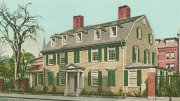1918
To save coal for the war effort, the University closes various buildings on selected days and cuts off heat to student dormitories after 9 p.m.
1928
Harvard Medical School researchers George R. Minot and William P. Murphy prove that eating half a pound of mammal liver or kidney daily will improve and maintain the health of a patient with pernicious anemia. Though the kidney and liver may be either raw or cooked, Minot and Murphy observe that most patients prefer to ingest the substance as raw pulp or mash.
1933
The Board of Overseers approves the creation of President Lowell’s long-cherished project, the Society of Fellows.
1938
The Nieman Fellowships are created when the President and Fellows, in accordance with the provisions of a $1-million bequest from Mrs. Agnes Wahl Nieman, approve a plan “to promote and elevate the standard of journalism in the United States.”
1953
Professor Kirtley Mather, on retiring as president of the American Association for the Promotion of Science, warns that the stultifying atmosphere imposed upon scientists by political trends is hurting the field and stifling intellectual freedom.
1968
President Nathan M. Pusey speculates that undergraduate tuition will be $4,000 by 1988. (It hit $12,015.)
1973
Assistant professor Ivan Tcherepnin proposes a new course, Music 159: “Composition with the Electronic Medium.” Though he anticipates resistance from his department—which is inherently distrustful of the new technology—his course is approved for the following year. The concern is raised, however, that offering credit for “tinkering with electronics” could set the stage for credit courses in such topics as basket-weaving and woodworking.








